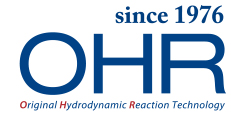[Wastewater treatment] Misconceptions about appropriate DO values in aeration tanks
What really is the appropriate DO value for your aeration tank?
In addition, is there a better alternative measuring method to the DO meter?
DO (Dissolved Oxygen) value is utilized for management guidelines at wastewater treatment plants around the world, but people who understand deeply about DO are very few. Also many people believe that the DO meter gives us adequate information, and the higher the DO the better. However in most cases this is not true. This incorrect thinking is encouraged by textbooks that say the DO value in the aeration tank should ideally be at least 2.0mg/L, and the higher the better.
The following five questions are frequently asked by wastewater treatment managers to our company.
Q1: What is the real meaning of DO?
Q2: What DO value is appropriate?
Q3: The higher the DO value the better?
Q4: How to measure DO correctly?
Q5: Are there more effective measuring instruments available to replace the DO meter?
We have been involved in wastewater treatment for over 40 years. Our knowledge of DO based on practical experience is as follows:
Q1: What is the real meaning of DO?
DO is an ‘excess’ that has not been consumed by microorganisms
For example, when you measure general tap water using a DO meter, you will often get a high value of 8 to 9mg/L which is almost saturated, and when you measure poor oxygen water (e.g. well water), you will often get a DO value of 0mg/L.
DO meters can measure [how much oxygen is dissolved in the water]. However, with regard to DO in the aeration tank, you should think in terms of what DO means [how much excess oxygen has been dissolved].
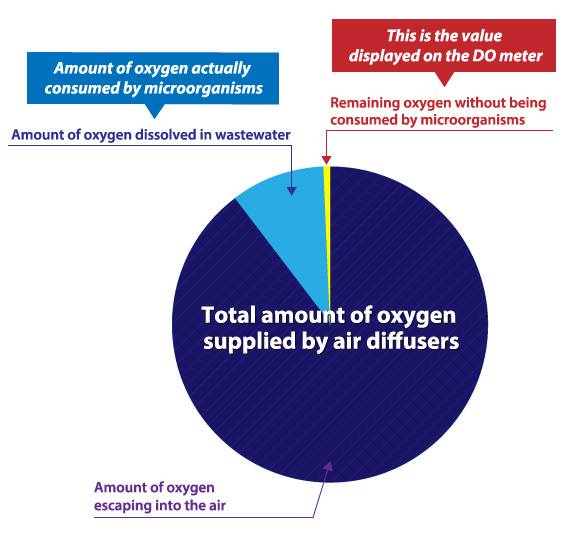 The reason we do aeration in an aeration tank is
because we must always compensate oxygen consumed by microorganisms in the tank. Oxygen supply is absolutely necessary in order to treat wastewater using aerobic microorganisms. Oxygen supplied to the water by air diffusers is consumed instantly by microorganisms.
The reason we do aeration in an aeration tank is
because we must always compensate oxygen consumed by microorganisms in the tank. Oxygen supply is absolutely necessary in order to treat wastewater using aerobic microorganisms. Oxygen supplied to the water by air diffusers is consumed instantly by microorganisms.
Even with the use of high performance air diffusers, the oxygen transfer rate in actual wastewater is 10% at most.
(For details, see ‘What is the Alpha value?’)
This is the part indicated in light blue in the diagram on the right. Therefore the remaining 90% goes into the air (indicated in dark blue).
The microorganisms in the aeration tank use most of the dissolved oxygen, but the ‘excess’ which is not effectively used remains in the wastewater. This is the DO indicated in yellow.
Now we come to the heart of the matter. Why create excess such as DO=2.0mg/L or more?
Keeping DO=2.0mg/L or more according to the wastewater treatment textbooks means continuing to supply excessive oxygen that is not used by microorganisms, and a lot of air blower power is wasted. With the exception of keeping a high DO in order to prepare for rapid wide change in BOD/COD load, it is clearly a mistake to maintain DO=2.0mg/L without good reason.
Q2: What DO value is appropriate?
DO=0mg/L is usual in the first aeration tank
Ask experienced wastewater treatment technicians “What DO value is appropriate in an aeration tank?”. Very few of them would answer “DO of 2.0mg/L or more is necessary”. Almost all technicians agree that even the smallest of DO values is enough. The appropriate DO value is as follows:
*The appropriate DO value is different depending on the position (upstream, midstream, downstream) of the aeration tank because
the purpose of each aeration tank is different. If there are three aeration tanks i.e. first, second and third aeration tanks:
● Second aeration tank (midstream area) : DO=0.1mg/L or more is enough.
● Third aeration tank (downstream area) : DO=0.3~1.0mg/L is enough.
* The DO meter is a measuring instrument for the dissolved oxygen concentration. Even if you measure anaerobic water (water that consumes oxygen),
it is not displayed as minus and is displayed as zero. In the above box “0mg/L of DO is normal in the first aeration tank” means the water is non
anaerobic or slightly anaerobic. Hence there is no problem with zero DO in the state where there is no excess or deficiency of oxygen. However, when
the water in the first aeration tank is noticeably anaerobic conditions, this is a problem. For details, refer to Question 5 below.
Q3: The higher the DO value the better?
Too strong aeration causes sedimentation failure in the sedimentation tank
There are wastewater treatment plants that unnecessarily keep a high DO by strongly aerating the final aeration tank. In cases where
activated sludge (microorganisms) and treated water is separated in the sedimentation tank, strong aeration in the final tank breaks
the flocs of aggregated microorganisms into very small flocs called pinflocs that are suspended in water and do not settle well in the
sedimentation tank. This phenomenon is caused by ‘over-aeration’. It may cause carry-over which means activated sludge flows out
with treated water.
Even with MBR systems, which forcibly separate activated sludge and treated water through a membrane, clogging of the membrane
is likely to occur when strong aeration breaks the flocs. So even in this case, over aeration is problematic.
To avoid floc breaking, it is necessary and important to regulate the aeration intensity by strongly aerating the upstream area,
moderately aerating the midstream area, and mildly aerating the downstream area. When more oxygen than necessary is supplied
to microorganisms, the microorganisms will not become active and the wastewater treatment conditions will not improve. Producing
the excess oxygen wastes much energy and money.
Q4: How to measure DO correctly?
In many cases ‘oxygen in bubbles’ as opposed to ‘dissolved oxygen’ is measured
The common way to measure DO is to take a sample of water from the aeration tank using a ladle, and measure the DO of the sampled water using a DO meter. But this way the water is exposed to the air affecting the DO. Another disadvantage is that it can measure only the DO of the surface layer of the aeration tank.
Our DO measuring method is to attach an electrode with a 10m long cable to a handy type DO meter and throw it directly into the aeration tank. This method can directly measure the actual DO. The electrode drops through water measuring the DO of the surface layer, middle layer, and lower layer. If the DO difference between the surface layer and the lower layer is significant it means that there is a difference in MLSS concentration in the aeration tank and the air diffusers could not uniformly churn the aeration tank.
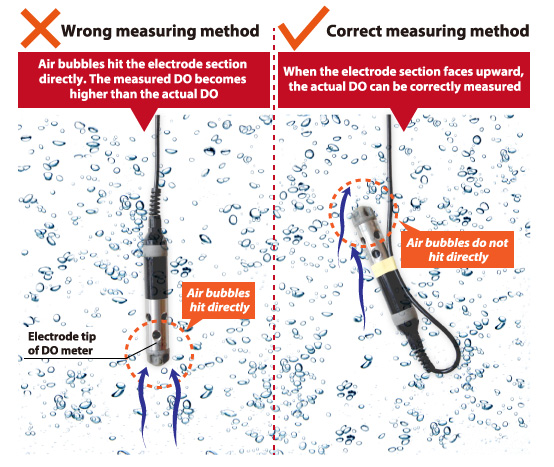
When measuring the DO using the above method,
careful consideration about the direction of the
electrode tip of the DO meter is required. When
you throw in the meter normally, the electrode tip
will face downwards. To avoid this, bend the cable
and fix the electrode with the cable using vinyl
tape, then the electrode tip will face upwards as
shown in the picture on the right.
This devised method prevents air bubbles from
air diffusers directly hitting the electrode tip and
measuring undissolved oxygen as DO. When the
electrode is facing upwards, discharged bubbles
from the air diffusers do not attach directly to the
electrode tip. Only following this devised method
can the DO be accurately measured.
(This method is very important, but in most cases it is measured with the electrode tip facing downwards. This means there are many
cases where DO is not measured correctly and undissolved oxygen is measured.)
Q5: Are there more effective measuring instruments available to replace the DO meter?
The ORP meter is far more effective than the DO meter
It is more effective to manage aeration in wastewater treatment by ORP value and not by DO value. ORP is Oxidation-Reduction Potential and it can measure a wide range of plus 2,000mV to minus 2,000mV informing us whether the liquid is in an oxidation state or a reduction state. Portable types similar to DO meters are sold, and you can throw it directly into the aeration tank and measure the ORP value when you attach a 10m long cable. The biggest advantage of using the ORP meter is that the ORP meter can measure both plus and minus range, so you can figure out how much oxygen is insufficient.
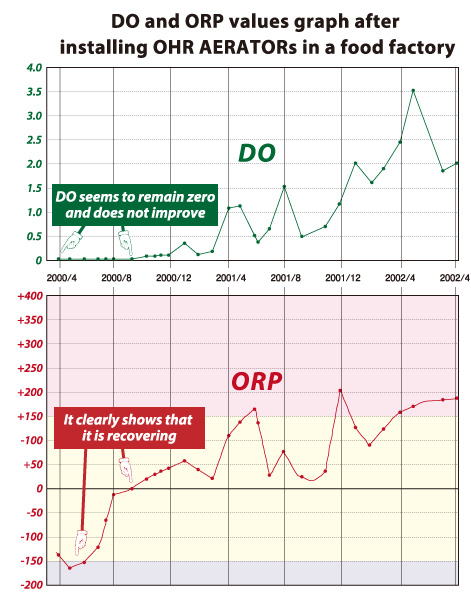 Please see the graph on the right. The graph shows both the
DO value and ORP value for two years after installing OHR
AERATORs in a food factory.
Please see the graph on the right. The graph shows both the
DO value and ORP value for two years after installing OHR
AERATORs in a food factory.
At this site, large amounts of anaerobic sludge accumulated
on the tank bottom. The sludge was strongly churned up by
OHR AERATORs and became severely oxygen-deficient.
(The customer chose to install the OHR AERATOR without
draining water and removing the anaerobic sludge.)
The upper green line is the result as measured by a DO meter. DO was 0mg/L over the four months after installing the OHR AERATORs (April 2000). If this DO result was the only assessment standard the OHR AERATOR would be considered to be a low efficiency air diffuser.
However, looking at the red line below (ORP result), you can see
that the aeration tank condition is clearly recovering. Therefore,
it can be clearly confirmed that the aeration tank condition is
recovering now and will definitely improve as time goes on.
So ‘DO=0mg/L’ has two meanings as follows:
A) Zero indicating that supply and consumption of oxygen are
balanced.
B) Zero indicating that oxygen consumption exceeds oxygen
supply.
The ORP meter enables you to see both the above two states. The ORP meter has been gradually recognized as very effective, and
the number of wastewater treatment plants using the ORP meter are increasing.
Appropriate ORP value in aeration tanks
Please keep within the range of minus 150mV to plus 150mV
The appropriate ORP value is different depending on the position (upstream, midstream, downstream) of the aeration tank in common with DO value. If there are three aeration tanks i.e. first, second, and third aeration tanks:
● Second aeration tank (midstream area) : Approx 0mV is enough.
● Third aeration tank (downstream area) : 150mV or less is enough.
*If the ORP value exceeds plus 150mV, it is classed as ‘over-aeration’. It is necessary to reduce the air blowing amount.
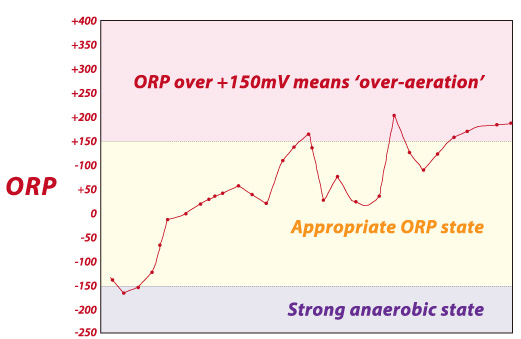 Applying this guideline to the previous ORP graph is shown
on the right.
Applying this guideline to the previous ORP graph is shown
on the right.




